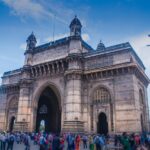A Tug-of-War Between Ideals and Pragmatism in India’s Most Populous State
Lucknow – Uttar Pradesh, the microcosm of India’s cultural, political, and social dynamics, is at a pivotal moment in its history. With a population exceeding 240 million, the state’s transformation has implications that resonate far beyond its borders. Yet, the forces driving this change remain a topic of debate: Are they rooted in centuries-old philosophical ideals, or are they shaped by calculated political strategy?
From the Gandhian ethos of village empowerment to the modern-day political calculus of welfare schemes, the story of change in Uttar Pradesh is one of contrasts, convergence, and, at times, contention.
Key Metrics Reflecting Change in Uttar Pradesh
- Economic Growth: Uttar Pradesh’s Gross State Domestic Product (GSDP) grew by 8.1% in 2022-23, one of the highest growth rates among Indian states (State Economic Survey, 2023).
- Political Influence: The current administration holds a significant majority, with 255 seats in the 2022 Assembly elections, enabling decisive governance reforms (Election Commission of India).
- Social Empowerment: Over 30 million women have benefited from Mission Shakti, showcasing a focus on gender equality (UP Government Report, 2023).
- Youth Demographics: With 35% of its population under 35, Uttar Pradesh is heavily shaped by the aspirations of its young citizens (Census 2011).
Philosophical Foundations of Change
1. Gandhian Principles of Self-Reliance
The legacy of Mahatma Gandhi’s Gram Swaraj (village self-rule) continues to inspire grassroots movements in rural Uttar Pradesh.
- In Action: Water conservation projects in Bundelkhand and organic farming initiatives reflect the Gandhian ideals of sustainability and community-led development.
- Modern Adaptation: Self-help groups across rural districts are combining traditional wisdom with modern tools, empowering women and small-scale entrepreneurs.
2. Ambedkarite Vision of Equality
Dr. B.R. Ambedkar’s advocacy for caste and gender equity remains a powerful philosophical force.
- Present Impact: Policies aimed at improving access to education and employment for marginalized communities, such as scholarships and job reservations, align with Ambedkar’s ideals.
- Grassroots Movements: Dalit rights groups in Purvanchal are actively challenging systemic discrimination, pushing for accountability and inclusion.
3. Sufi-Bhakti Traditions of Unity
The syncretic teachings of the Bhakti and Sufi movements, emphasizing love, equality, and interfaith harmony, continue to influence Uttar Pradesh’s cultural and social fabric.
- Cultural Reflection: Shrines like the Dargah Sharif in Bareilly and events such as joint Holi-Eid celebrations underscore the enduring relevance of these philosophies.
Political Strategies Driving Change
1. Infrastructure-Driven Transformation
Political strategies have heavily leaned on infrastructure as a tool for progress.
- Key Projects:
- The Purvanchal Expressway connects underdeveloped regions with economic hubs, facilitating trade and mobility.
- The Jewar International Airport positions Uttar Pradesh as a logistical and tourism powerhouse.
2. Welfare-Centric Policies
Programs designed to uplift marginalized communities reflect a calculated approach to addressing voter concerns.
- Mission Shakti: With direct benefits to millions of women, this flagship initiative has successfully addressed gender disparity while securing a significant political mandate.
- One District One Product (ODOP): This scheme promotes local industries and artisans, boosting exports and employment opportunities.
3. Political Messaging and Identity
The reconstruction of spiritual and cultural landmarks, such as the Kashi Vishwanath Corridor, serves as a dual strategy—restoring heritage while solidifying political appeal.
Philosophy Meets Strategy: Where They Converge
1. Women’s Empowerment
- Philosophical Ideal: Feminist principles of equality, rooted in both Gandhian and Ambedkarite thought, advocate for women’s liberation.
- Strategic Implementation: Programs like Mission Shakti convert these ideals into actionable policies, delivering both social progress and political dividends.
2. Economic Growth and Environmental Sustainability
- Philosophical Ideal: Gandhian teachings emphasize harmony with nature.
- Political Strategy: Infrastructure projects are increasingly tied to sustainability goals, although critics highlight gaps between rhetoric and action.
3. Communal Harmony
- Philosophical Ideal: The teachings of Kabir and Rahim advocate for unity and coexistence.
- Political Strategy: While policies aim to bridge divides, political rhetoric sometimes deepens polarization, complicating the ideal of harmony.
Challenges in Driving Change
- Polarization: Political strategies occasionally exploit social and religious divides, undermining efforts toward unity and inclusion.
- Economic Disparity: Urban centers like Noida thrive, while rural regions such as Bundelkhand lag behind, reflecting unequal development.
- Generational Divide: Younger populations push for faster, more pragmatic solutions, sometimes clashing with the philosophical ideals cherished by older generations.
The Way Forward
1. Aligning Governance with Ideals
- Integrate Gandhian and Ambedkarite principles into long-term policy planning to ensure equity and sustainability.
2. Empowering Grassroots Movements
- Strengthen local governance through the Panchayati Raj system, allowing communities to lead change from within.
3. Promoting Cultural and Interfaith Harmony
- Expand programs celebrating Bhakti and Sufi traditions to reinforce the state’s syncretic heritage and counter polarization.
Conclusion
Uttar Pradesh’s transformation is neither purely philosophical nor solely strategic—it is a complex interplay of both. The state’s ancient ideals provide a moral compass, while its political strategies determine the pace and direction of change.
As Uttar Pradesh navigates this delicate balance, its success will depend on harmonizing its philosophical legacy with pragmatic governance, creating a model for inclusive and sustainable progress in India’s most populous state.











